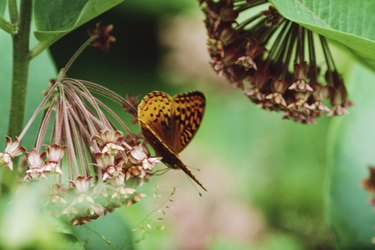
Common milkweed (Asclepias syriaca) with its clusters of fragrant, mauve-colored flowers is a valuable addition to a butterfly garden, attracting scores of the winged creatures The plant typically grows to 4 feet, though occasionally it reaches heights of up to 6 feet. Though pruning isn't necessary, common milkweed may be pruned to keep it looking neat and tidy.
Pruning
Video of the Day
Because milkweed is a host plant for the caterpillars of many butterflies, it may end up looking raggedy from defoliation. If you don't want to lose too much height, you can cut the plant back in early summer by about 50 percent. This will encourage it to produce new side sprouts. At the end of the growing season, you can cut the stems back to 4 to 6 inches.
Video of the Day
Warning
When broken, the stems and leaves release a toxic, milky white sap that can be irritating to the skin. If you get the sap in your eyes, Butterfly Encounters recommends seeking medical attention. When pruning or taking cuttings, wear gloves to protect your skin. Though parts of the plant are edible if properly prepared, related species in the milkweed genus are toxic if ingested, according to the North Carolina State University Extension. Symptoms may include vomiting, weakness and spasms.
Culture
Milkweed is suitable for U.S. Department of Agriculture plant hardiness zones 3 to 9, where it prefers full sunlight and well draining soil. The plant is quite drought tolerant and prefers somewhat dry, poor soils. You may wish to prune off the brown seed pods before they split open because the plant self-seeds easily. Once established, milkweed can be challenging to remove due to its mat-like rhizomes, though these rhizomes make the plant useful for erosion control.
Features
Milkweed is a low maintenance plant that will generally do fine when left to its own devices. The plant is seldom bothered by deer. And it and can have a naturalizing effect in a butterfly-oriented garden. Milkweed may be propagated by green stem cuttings, taken in the spring, dusted with hormone root powder and placed in moist sand or potting soil. Cuttings can be planted directly in a sunny part of the garden in 6 to 10 weeks.